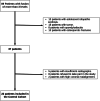Long-term impact of sagittal malalignment on hardware after posterior fixation of the thoracolumbar spine: a retrospective study
- PMID: 32546153
- PMCID: PMC7298821
- DOI: 10.1186/s12891-020-03405-z
Long-term impact of sagittal malalignment on hardware after posterior fixation of the thoracolumbar spine: a retrospective study
Abstract
Background: The importance of sagittal alignment in healthy individuals and in reconstructive spinal surgery has been studied over the last 15 years. The aim of the present study was to assess the long-term effects of abnormal sagittal alignment on hardware after posterior thoracolumbar spinal fusion.
Methods: Patients who had undergone revision surgery (revision cohort, n = 34) due to breakage of their implants were compared retrospectively with patients who had intact implants at the final follow-up investigation after a long posterior thoracolumbar and/or lumbar spinal fusion (control cohort, n = 22). Clinical data and radiological parameters including the sagittal vertical axis (SVA), pelvic incidence (PI), lordosis gap (LG), pelvic tilt (PT), sacral slope (SS), lumbar lordosis (LL), thoracic kyphosis (TK), and the femoral obliquity angle (FOA) were assessed on full-spine lateral radiographs obtained in regular standing position. Data were analysed using descriptive statistics, parametric and non-parametric inferential statistics.
Results: Patients in the breakage group (female n = 21, male n = 9, mean age 60.9 ± 15.6 years) had a higher anterior shift of the C7 plumb line (SVA) (p = 0.02), retroversion of the pelvis (PT) (p < 0.001), PI-LL mismatch (LG) (p = 0.001), and PI (p = 0.002) than the intact group (female n = 10, male n = 12, mean age 65.7 ± 12.4 years). No significant difference was registered between groups in regard of SS, LL, TK, FOA, and the mean number of comorbidities.
Conclusion: Failure of restoration of the SVA and the LG to the acceptable ranges, especially in patients with a high PI, may be regarded as a risk factor for the long-term failure of implants after posterior thoracolumbar spinal fusion.
Keywords: Failure of the implants; Posterior fixation; Sagittal alignment; Thoracolumbar spine.
Conflict of interest statement
The authors declare that they have no competing interests.
Figures
References
MeSH terms
LinkOut - more resources
Full Text Sources
Medical
Research Materials
Miscellaneous


